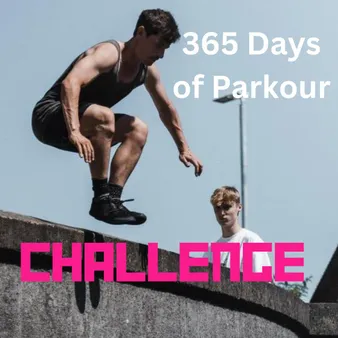Table of Contents
In the realm of movement and personal growth, Kizworld presents "How to overcome obstacles and challenges with parkour," a comprehensive guide to conquering physical and mental barriers. Parkour, a discipline that seamlessly blends agility, strength, and problem-solving, offers a unique platform for individuals to transcend their limits and cultivate resilience. This guide delves into essential techniques, effective training methods, and the importance of community support, empowering traceurs to navigate obstacles with grace, skill, and unwavering determination.
How to overcome obstacles and challenges with parkour: Tips and tricks like a pro
I. How to Overcome Obstacles and Challenges with Parkour
How to Overcome Obstacles and Challenges with Parkour
Mastering Your Mindset: Embracing Challenges as Opportunities for Growth
Parkour is more than just a physical activity; it's a philosophy that teaches us to overcome obstacles and challenges with grace, skill, and determination. Whether you're facing a physical barrier or a mental block, parkour can equip you with the tools to push your limits and unlock your full potential. At its core, parkour is about embracing challenges as opportunities for growth and learning, rather than letting them hold you back.
Essential Techniques for Overcoming Physical Obstacles
Parkour is a discipline that requires a combination of strength, agility, and technique. To overcome physical obstacles, it's essential to master fundamental techniques such as vaults, climbs, and rolls. These techniques allow traceurs (parkour practitioners) to navigate their environment creatively and efficiently, turning obstacles into stepping stones toward their goals.
Table: Essential Parkour Techniques and Their Benefits
| Technique | Benefits ||---|---|| **Vaults:** Jumping over obstacles with both feet at once | Develops leg strength, explosiveness, and coordination || **Climbs:** Scaling walls and other vertical surfaces | Improves grip strength, upper body strength, and problem-solving skills || **Rolls:** Breaking falls safely and efficiently | Reduces the risk of injury and allows traceurs to maintain momentum || **Precision Jumps:** Landing accurately on small or moving targets | Enhances balance, coordination, and focus || **Wall Runs:** Running up walls or other vertical surfaces | Builds explosive power, leg strength, and core stability |
Breaking Through Mental Barriers: Cultivating Resilience and Perseverance
Parkour is not just about overcoming physical obstacles; it's also about conquering mental challenges. The discipline teaches traceurs to face their fears, push their limits, and persevere in the face of adversity. Mental resilience and perseverance are crucial for overcoming the self-doubt, fear, and anxiety that can hold us back from achieving our goals.
- How to Develop Mental Resilience in Parkour
- How to Improve Your Flexibility and Mobility with Gymnastics
- The Benefits of Gymnastics for Kids
The Importance of Community and Support
Parkour is a community-oriented discipline. Traceurs often train together, share knowledge, and encourage each other to push their limits. This sense of community provides a supportive environment where individuals can learn from each other, grow together, and overcome challenges as a team.
Developing Perseverance and Resilience: Embracing Failure as a Stepping Stone to Success
In parkour, failure is not seen as a setback but as an opportunity to learn and improve. Traceurs embrace failure as a natural part of the learning process and use it as fuel to keep pushing forward. They understand that every fall or missed jump is a chance to refine their technique and come back stronger.
List: Tips for Developing Perseverance and Resilience in Parkour
- Set realistic goals and break them down into smaller milestones.
- Celebrate your successes, no matter how small.
- Learn from your mistakes and use them as opportunities to improve.
- Stay positive and motivated even when things get tough.
- Surround yourself with supportive friends and training partners.
Staying Safe While Pushing Your Limits: Prioritizing Safety and Injury Prevention
While parkour encourages pushing limits and overcoming challenges, it's essential to prioritize safety and injury prevention. Traceurs must learn proper technique, warm up adequately, and assess risks before attempting new moves. They also need to listen to their bodies and rest when necessary to avoid overtraining or injury.
Training Tips for Beginners: Getting Started with Parkour
For beginners interested in starting parkour, it's crucial to find a qualified instructor and a safe training environment. Classes and workshops can teach you the basics of parkour and help you develop the necessary skills and techniques to train safely and effectively. Additionally, regular practice is essential for improving your abilities and overcoming challenges.
The History and Philosophy of Martial Arts
Progressing Safely: Intermediate Level Techniques
As traceurs progress in their training, they can learn more advanced techniques such as flips, spins, and complex combinations. These moves require a high level of skill, strength, and coordination. It's important to master the basics before attempting advanced techniques and to always practice with safety in mind.
Advanced Parkour: Overcoming Extraordinary Challenges
Advanced parkour involves pushing the limits of human movement and overcoming extraordinary challenges. Traceurs at this level can perform gravity-defying stunts, navigate complex obstacles courses, and flow through urban environments with incredible skill and precision.
Parkour as a Mindset for Life: Beyond Physical Challenges
Parkour's principles and teachings extend beyond physical challenges. The discipline cultivates a mindset of resilience, adaptability, and creativity that can be applied to all aspects of life. Traceurs learn to approach problems with a fresh perspective, to see obstacles as opportunities, and to embrace challenges as a catalyst for growth.
II. Mental Preparation for Overcoming Obstacles
Mental Preparation for Overcoming Obstacles
Cultivating a Positive Mindset
Embarking on a parkour journey demands a mindset shift, embracing challenges as opportunities for growth. Visualize success, picturing yourself effortlessly navigating obstacles, and believe in your abilities. Replace self-doubt with affirmations, reinforcing your competence and resilience. Celebrate small victories along the way, building momentum and motivation.
Related: The Benefits of Parkour for Physical and Mental Development
Benefit | Impact on Parkour Performance |
Increased Confidence | Enhances risk-taking and willingness to try new moves |
Reduced Fear and Anxiety | Promotes focus and concentration during challenging maneuvers |
Enhanced Motivation | Drives consistent practice and progression |
Greater Resilience | Enables persistence in the face of setbacks |
Developing Mental Toughness
Mental toughness is a crucial trait for parkour athletes, enabling them to push through physical and mental barriers. Embrace discomfort and challenges as opportunities to build resilience. Set ambitious goals, breaking them down into smaller, achievable steps. Celebrate progress, no matter how small, and learn from setbacks, viewing them as learning experiences.
Related: How to Improve Your Speed, Agility, and Creativity with Parkour
- Practice mindfulness: Focus on the present moment, staying calm and composed during challenging situations.
- Visualize success: Imagine yourself overcoming obstacles with ease, building confidence and motivation.
- Embrace challenges: View obstacles as opportunities for growth, rather than hindrances.
- Set realistic goals: Break down long-term goals into smaller, achievable steps, maintaining a sense of progress.
- Celebrate progress: Acknowledge and celebrate your achievements, no matter how small.
Building Self-Confidence
Self-confidence is a cornerstone of parkour, empowering athletes to take calculated risks and push their limits. Engage in self-reflection, identifying your strengths and areas for improvement. Set realistic goals, gradually increasing the difficulty as you progress. Surround yourself with supportive friends and mentors who believe in your abilities. Celebrate your accomplishments, big and small, and learn from your mistakes, viewing them as opportunities for growth.
Related: The Top Parkour Competitions and Events
III. Physical Preparation for Overcoming Obstacles
Physical Preparation for Overcoming Obstacles
Embarking on a parkour journey requires a solid foundation of physical fitness. This entails developing strength, agility, and flexibility to navigate challenging obstacles with grace and ease. Here's a comprehensive guide to help you prepare your body for the demands of parkour:
Strength Training: Building muscle strength is essential for propelling yourself over obstacles and executing dynamic movements. Focus on compound exercises like squats, deadlifts, and bench presses to target multiple muscle groups simultaneously. Read our detailed guide on building muscle with calisthenics.
Exercise | Targets | Benefits |
Squats | Legs, glutes | Builds lower body strength for jumping and landing |
Deadlifts | Back, hamstrings | Develops core strength and power |
Bench Press | Chest, triceps | Enhances upper body strength for climbing and vaulting |
Agility Training: Agility is key to adapting quickly to unexpected obstacles and maintaining balance. Incorporate plyometric exercises like box jumps, single-leg hops, and lateral bounds into your routine. Discover more ways to enhance your agility.
Flexibility Training: Good flexibility allows for greater range of motion and reduces the risk of injuries. Engage in dynamic stretches before workouts and static stretches afterward. Focus on areas like hamstrings, quadriceps, and hips. Learn effective flexibility.
Cardio Training: Cardiovascular endurance is vital for sustaining energy throughout parkour sessions. Engage in activities like running, cycling, or swimming to improve your heart and lung capacity. Get started with running for beginners.
Warm-up and Cool-down: Never neglect warming up before and cooling down after your parkour sessions. These routines minimize the risk of injuries, improve muscle recovery, and enhance flexibility. Incorporate dynamic stretches, light cardio, and foam rolling into your warm-up and static stretches, light cardio, and foam rolling into your cool-down routine.
Remember, physical preparation is an ongoing process that requires dedication and consistency. Gradually increase the intensity and difficulty of your workouts as you progress in your parkour journey to overcome obstacles like a pro!
IV. Techniques for Overcoming Obstacles
Techniques for Overcoming Obstacles
Mastering the Art of Parkour
Parkour, a discipline that demands both physical prowess and mental fortitude, presents a unique set of obstacles and challenges. Overcoming these hurdles requires a combination of techniques, skills, and a mindset capable of conquering life's toughest moments. This comprehensive guide provides essential techniques, tips, and training advice to help traceurs overcome obstacles and challenges with grace, skill, and determination.
- Precision and Control: Mastering the art of parkour requires precise movements and controlled landings. Traceurs must develop the ability to accurately judge distances, angles, and momentum to navigate obstacles safely and efficiently.
- Adaptability and Flexibility: Parkour demands adaptability and flexibility in the face of unexpected challenges. Traceurs must be able to assess their surroundings quickly, identify alternative routes, and adjust their movements accordingly.
- Strength and Conditioning: Building strength and conditioning is crucial for parkour. Traceurs need strong muscles to propel themselves over obstacles, land safely from jumps, and maintain endurance during extended training sessions.
Essential Parkour Techniques
Parkour encompasses a wide range of techniques that allow traceurs to overcome obstacles and challenges. Some of the most fundamental techniques include:
- The Vault: A basic parkour technique that involves jumping over an obstacle using both hands and feet.
- The Roll: A technique used to absorb the impact of a fall or landing, minimizing the risk of injury.
- The Wall Run: A technique that allows traceurs to run up a wall for a short distance, often used to gain height or access a higher platform.
- The Precision Jump: A controlled jump that requires accuracy and timing to land safely on a specific target.
- The Cat Leap: A technique that involves jumping over an obstacle while maintaining a low profile, often used to avoid detection or clear low-hanging obstacles.
These techniques, when combined with proper training and a positive mindset, empower traceurs to overcome obstacles and challenges with confidence and skill.
Developing a Parkour Mindset
Beyond physical techniques, developing a parkour mindset is essential for overcoming obstacles and challenges. This mindset includes:
- Embracing Challenges: Traceurs approach obstacles as opportunities for growth and development, rather than as barriers to be avoided.
- Perseverance and Resilience: Parkour requires perseverance and resilience in the face of setbacks and failures. Traceurs learn to persist until they achieve their goals.
- Creativity and Problem-Solving: Parkour encourages creativity and problem-solving, as traceurs must find innovative ways to overcome obstacles using the available resources.
- Respect for the Environment: Traceurs respect the environment and strive to minimize their impact on natural and urban landscapes.
By cultivating this mindset, traceurs develop the mental strength and resilience necessary to overcome obstacles and challenges both in parkour and in life.
Conclusion
Overcoming obstacles and challenges with parkour is a journey of self-discovery, physical development, and mental growth. By mastering essential techniques, developing a parkour mindset, and embracing the challenges that come their way, traceurs unlock their full potential and achieve remarkable feats of athleticism and personal growth.
Whether you're a seasoned traceur or just starting your parkour journey, remember that the greatest obstacles are often the ones that lead to the most significant growth and transformation.
How to Do a Handstand: A Step-by-Step Guide for Beginners
V. Conclusion
Parkour is a discipline that not only challenges the physical body but also the mind, demanding resilience, perseverance, and a willingness to push boundaries. Embracing the challenges of parkour builds not just physical strength and agility, but also mental fortitude and an unwavering belief in one's abilities. Whether navigating urban landscapes or conquering natural obstacles, traceurs learn to adapt, overcome, and thrive in the face of adversity. Parkour transforms individuals into confident, capable, and resilient beings, equipped to tackle life's challenges with grace and determination.